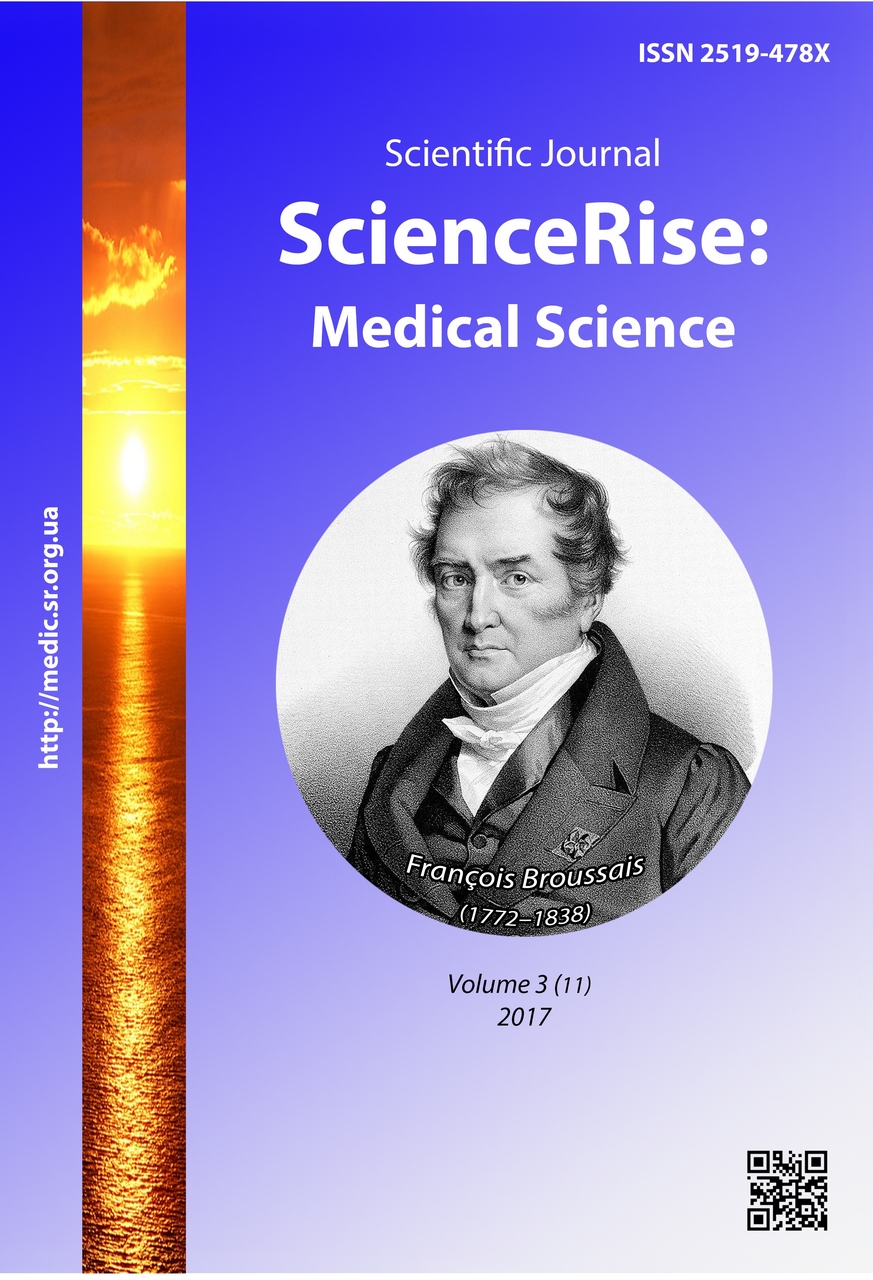The analysis of comorbidities in geriatric patients with proximal femur fracture
DOI:
https://doi.org/10.15587/2519-4798.2017.96422Keywords:
proximal femur, treatment methods, fracture, old age, comorbiditiesAbstract
The frequency of proximal femur fractures is 35 – 40 % in the structure of different skeletal fractures. Elderly people, usually having several somatic diseases, are the main contingent of patients with fractures of this localization. Comorbidities and general condition of patients should be considered for treatment strategy determination.
Aim. To study comorbidities structure in geriatric patients with proximal femur fractures and to estimate comorbidities influence on the choice of the treatment strategy.
Materrials and methods. 568 case histories of patients, hospitalized in the trauma department of Kharkiv clinical multy-field hospital № 17 with proximal femur fractures during 2008 – 2014, were analyzed.
Results. Most of the patients had low energy trauma. 568 patients were included in the research; 205 (36.09 %) of them were males, and 363 (63.91 %) – females. The age of patients ranged from 62 to 97 (the average age 79.2±9.1). Comorbidities were found in 378 patients (66.5 %). The time from the moment of injury to hospitalization ranged from 30 minutes to 4 weeks (25 hours on the average). The average number of bed capacity was 17 days (from 1 to 84 days). In 72.7 % of cases coronary heart disease was found, in 47.6 % - hypertension, and diabetes mellitus – in 10.8 %. One comorbidity was found in 131 patients (34.65%), two comorbidities – in 153 patients (40.47 %), three or more was found in 84 patients (22.22 %). The surgical treatment was applied in 29.5 7% of cases, conservative – in 70.42 % of cases.
Conclusion. The elderly patients in 66.5% of cases have comorbidities, and cardiovascular pathology is the most common. The patients with the giving fractures need more detailed examination to select the optimal treatment strategy
References
- Kvitashvili, O. (Ed.) (2015). Shchorichna dopovid pro stan zdorovia naselennia, sanitarno-epidemichnu sytuatsiiu ta rezultaty diialnosti systemy okhorony zdorovia Ukrainy. 2014 rik. Kyiv, 460.
- Madridskiy mezhdunarodnyy plan deystviy po problemam stareniya 2002 goda (2002). Doklad vtoroj Vsemirnoj assamblei po problemam stareniya. New York: UN, 8.
- Girshin, S. G. (2004). Klinicheskie lektsii po neotlozhnoy travmatologii. Moscow: Azbuka, 543.
- Haiko, H. V., Strafun, S. S., Kalashnikov, A. V., Polishko, V. P. (2011). Analiz stanu travmatoloho-ortopedychnoi dopomohy naselenniu Ukrainy 2009–2010 rr. Kyiv: Volia, 220.
- Korzh, N. A., Gerasimenko, S. I., Klimovickij, V. G., Loskutov, A. E., Romanenko, K. K., Gerasimenko, A. S., Kolomiec, E. N. (2010). Rasprostranennost perelomov kostey i rezultaty ikh lecheniya v Ukraine (kliniko-epidemiologicheskoe issledovanie). Ortopediya, travmatologiya i protezirovanie, 3, 5–14.
- Dhanwal, D. K., Cooper, C., Dennison, E. M. (2010). Geographic Variation in Osteoporotic Hip Fracture Incidence: The Growing Importance of Asian Influences in Coming Decades. Journal of Osteoporosis, 2010, 1–5. doi: 10.4061/2010/757102
- Rizzoli, R., Body, J. J., De Censi, A., Reginster, J. Y., Piscitelli, P., Brandi, M. L. (2012). Guidance for the prevention of bone loss and fractures in postmenopausal women treated with aromatase inhibitors for breast cancer: an ESCEO position paper. Osteoporosis International, 23 (11), 2567–2576. doi: 10.1007/s00198-011-1870-0
- Ismailov, S. I., Khodzhamberdieva, D. Sh., Rikhsieva, N. T. (2013). Osteoporoz i nizkoenergeticheskie perelomy sheyki bedra kak oslozhnenie razlichnykh endokrinnykh zabolevaniy. Mezhdunarodnyj ehndokrinologicheskij zhurnal, 5, 113–120.
- Belyakin, S. A., Perekhodov, S. N., Peshekhonov, E. V. (2011). Vliyanie soputstvuyushchikh zabolevaniy na vybor metoda lecheniya pereloma sheyki bedrennoy kosti u postradavshikh pozhilogo i starcheskogo vozrasta. Klinicheskaya gerontologiya, 3-4, 13–17.
- Shevalaev, G. A., Dudina, Ye. V., Yefremov, I. M. (2011). Komorbidnost u bolnykh 50 let i starshe s perelomom proksimalnogo otdela bedrennoy kosti. Voprosy travmatologii i ortopedii, 1, 31–33.
- Panday, K., Gona, A., Humphrey, M. B. (2014). Medication-induced osteoporosis: screening and treatment strategies. Therapeutic Advances in Musculoskeletal Disease, 6 (5), 185–202. doi: 10.1177/1759720x14546350
- Golovach, I. Yu., Zazarnyy, I. M., Turovskaya, T. V. et. al. (2014). Otsenka komorbidnosti u patsientov s perelomom sheyki bedrennoy kosti na fone osteoporoza i posleduyushchim endoprotezirovaniem tazobedrennogo sustava. Ukrainskiy revmatologіchniy zhurnal, 3, 23–28.
- Briot, K., Maravic, M., Roux, C. (2015). Changes in number and incidence of hip fractures over 12years in France. Bone, 81, 131–137. doi: 10.1016/j.bone.2015.07.009
- Bijlsma, A. Y., Meskers, C. G. M., Westendorp, R. G. J., Maier, A. B. (2012). Chronology of age-related disease definitions: Osteoporosis and sarcopenia. Ageing Research Reviews, 11 (2), 320–324. doi: 10.1016/j.arr.2012.01.001
- Abizanda, P., Romero, L., Sanchez-Jurado, P. M., Martinez-Reig, M., Alfonso-Silguero, S. A., Rodriguez-Manas, L. (2014). Age, frailty, disability, institutionalization, multimorbidity or comorbidity. Which are the main targets in older adults? The Journal of Nutrition, Health & Aging, 18 (6), 622–627. doi: 10.1007/s12603-014-0033-3
- Kornilov, N. V., Gryaznukhin, E. G. (Eds.) (2006). Travmatologiya i ortopediya. Travmy i zabolevaniya nizhnej konechnosti. Vol. 3. Saint Petersburg: Gippokrat, 1053.
- Shaposhnikov, Yu. G. (Ed.) (1997). Travmatologiya i ortopediya. Vol. 2. Moscow: Meditsina, 592.
Downloads
Published
How to Cite
Issue
Section
License
Copyright (c) 2017 Andrii Kalchenko, Vladimir Babalyan, Alexander Khvysyuk, Tamara Hurbanova, Dmitriy Cherepov, Sergiy Maznyakov

This work is licensed under a Creative Commons Attribution 4.0 International License.
Our journal abides by the Creative Commons CC BY copyright rights and permissions for open access journals.
Authors, who are published in this journal, agree to the following conditions:
1. The authors reserve the right to authorship of the work and pass the first publication right of this work to the journal under the terms of a Creative Commons CC BY, which allows others to freely distribute the published research with the obligatory reference to the authors of the original work and the first publication of the work in this journal.
2. The authors have the right to conclude separate supplement agreements that relate to non-exclusive work distribution in the form in which it has been published by the journal (for example, to upload the work to the online storage of the journal or publish it as part of a monograph), provided that the reference to the first publication of the work in this journal is included.









